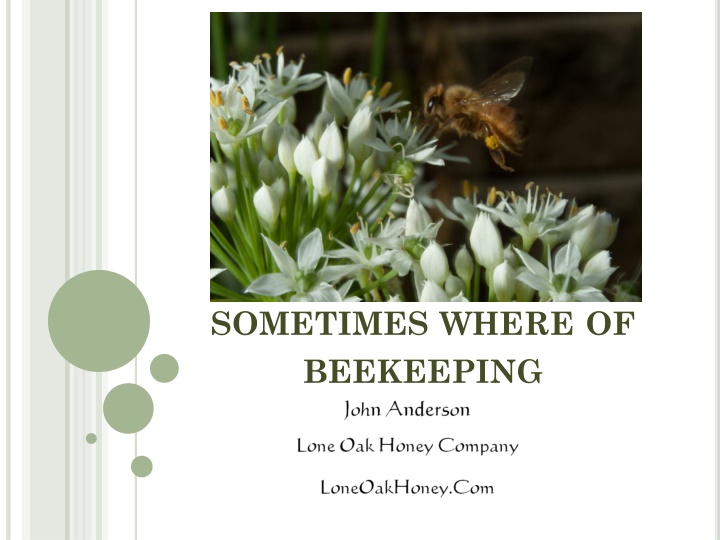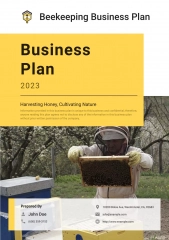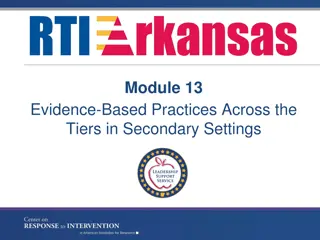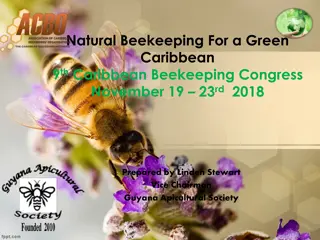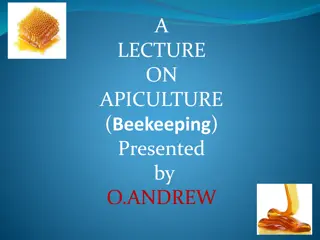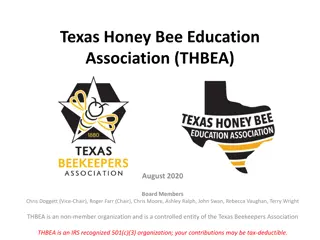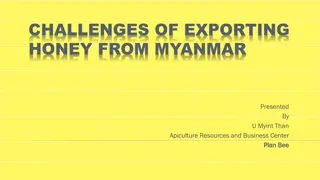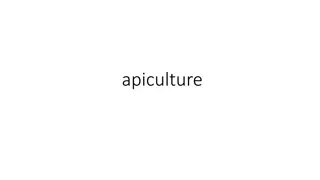Essential Practices and Considerations in Beekeeping
Understanding the key aspects of beekeeping such as climate considerations, the use of queen excluders, and the importance of timing in managing bee colonies. Highlighted are the pitfalls to avoid, especially in scenarios like overwintering and reversing brood boxes in spring. These insights aim to help beekeepers make informed decisions to ensure the health and well-being of their bees.
Download Presentation

Please find below an Image/Link to download the presentation.
The content on the website is provided AS IS for your information and personal use only. It may not be sold, licensed, or shared on other websites without obtaining consent from the author.If you encounter any issues during the download, it is possible that the publisher has removed the file from their server.
You are allowed to download the files provided on this website for personal or commercial use, subject to the condition that they are used lawfully. All files are the property of their respective owners.
The content on the website is provided AS IS for your information and personal use only. It may not be sold, licensed, or shared on other websites without obtaining consent from the author.
E N D
Presentation Transcript
WHY, WHEN, & SOMETIMES WHERE OF BEEKEEPING
SOME ADVICE IS ONLY GOOD IF YOU SHARE THE SAME CLIMATE OF THE BEEKEEPER GIVING THE ADVICE. MAKE SURE YOU ALWAYS TAKE CLIMATE INTO CONSIDERATION BEFORE FOLLOWING ANY BEEKEEPING ADVICE. SOMETIMES WE GET SO FOCUSED ON DOING THINGS TO HELP OUR BEES WE FORGET THE ACTUAL REASON WE ARE DOING CERTAIN THINGS OR WE LOSE SITE OF THE TIMING OF WHEN THINGS SHOULD BE DONE AND WHEN THEY SHOULDN'T BE DONE.
Queen Excluders Why do we use queen excluders? To keep the queen out of the honey suppers in order to keep brood out of the honey frames. When do we put the queen excluder on? When we add the honey supers. Does this mean anytime we have any honey supers on we keep the queen excluder on? What about if we leave one medium supper on the hive for overwintering? Should we leave the queen excluder on? What is going to happen in the winter as he cluster of bees move up the brood boxes and reach the queen excluder and the medium supper? The cluster will keep moving up, but the queen will not be able to get through the excluder. The worker bees won't know this and they will keep moving up and the queen will be stranded. With no other bees around her, or few bees around her, she is going to freeze and die.
The WHY we use queen excluders is to keep the queen confined in a certain area. We use queen excluders WHEN we want to keep the queen from moving up into the upper boxes. If you forget the why or the when and leave the excluder on in the winter you just created a situation that will kill the queen and therefore the whole hive. The WHERE with queen excluders is; maybe down south you can leave them on all year. Maybe it never gets cold enough that the bees cluster and have to move into the upper boxes in Texas, Florida or California.
Reversing boxes in spring Why do we reverse brood boxes in the spring? To give the bees room to move up. I do not do this. I think the bees more naturally move down in the spring. So the Why is debatable on this one but maybe you believe you should do it. So when do we do this? Anytime in the spring? What happens if the brood nest is currently in both boxes, mostly in the top box but some in the bottom box and it is still getting cold at night? If the cluster or brood spans both boxes and you reverse them you just broke up the cluster and now the bees can not keep the smaller patch of brood in the top box warm and they most likely will lose that brood. Even if it is not getting cold at night you still have broken up the brood nest and disrupted things and slowed the bees down. If the brood is in both boxes guess what, your bees are already expanding down, and maybe up. So you do not need to move any boxes anyway. The when to remember for reversing boxes is in the spring when all the bees and brood are in the top box.
EXPANDINGTHEBROODNEST Why do we add frames to the brood nest? To give the colony room so they do not swarm or to encourage them to expand and raise more bees before the flow. When do we add frames to the brood nest? When the nights are not too cool and the bee population is large enough the bees can quickly fill the gap left by removing a frame. What happens if you add an empty frame to the brood nest when it is still getting cold at night? The frame is not drawn yet so it leaves a big empty space by the two brood frames you put the empty frame between. The bees have to keep the brood warn to keep it alive. They do this by filled the space around the brood with bees and generating heat. Now that you gave them more space it will take more bees, many more bees, to fill it and keep the brood warm. If there are not enough bees to fill all that space then they can not keep the brood warm enough and it will get chilled and die. When the brood nest is getting filled with nectar: Michael Bush's advice is to add undrawn frames to the brood nest when you are trying to prevent swarming. He says the bees will start to draw the cells out and before each cell is drawn out very far the queen will lay in it. She will lay in it before it is drawn enough for the bees to put nectar in it. This really helps prevent swarming when the brood nest has become backfilled with nectar.
Using a bee escape Why do you use a bee escape? To get the bees to move out of the honey supers, and not let them back in, so that you can harvest frames of honey and not have to brush the bees off. When do you use a bee escape? A day or two before you want to harvest honey and when the nighttime temperatures are dropping enough that the bees are heading into the brood nest at night to help keep the brood warm. Notice that this when includes one or two days before you want to harvest honey . Why is that? What happens to honey frames that do not have any bees to guard them in August? Wax months happen! It takes wax moth eggs 3 to 5 days to hatch. The eggs are probably already on the honey frames but when there are bees present they can take care of them when they hatch. If you leave a bee escape on for a week, even if there were no eggs already, a wax moth will find them and lay eggs. So you will end up with wax moth larva in the honey frames and the honey will be ruined.
Also, if the weather is hot you dont want to leave the bee escape on for longer than overnight. If the honey frames get too hot the wax can melt and the honey can leak out. Bees cool the supers when they need to. But if the bee escape gets the bees out of the supers, then they can't cool things down when it gets hot. The other scenario is, if you leave the bee escape on long enough the bees will figure out how to get through it and get back up into the honey supers.
WHEREUSEABEEESCAPE? PROBABLY NEVERINAREASWHEREITDOESNOTCOOLOFF ATNIGHTWHENTHEHONEYNEEDSTOCOME OFF. Also on the subject of wax moths. Since the max moth eggs are probably already on the honey frames when you harvest them you need to extract the honey before they hatch. If you can not extract within 3 to 5 days of the bees being cleared off the frames then you need to freeze the frames to kill the eggs. Freezing for 72 hours should be more than enough to kill the eggs. You can extract honey frames after they have been frozen. Thaw them out with a dehumidifier or at least a fan blowing on them to keep condensation to a minimum so you do not add moisture to the honey. Do not take the honey frames into your house thinking you will keep the wax moths away from them. If the eggs are on the frames already they will hatch in your house! They can be very hard to get rid of once they are in your house!
FEEDING SUGAR SYRUP Why feed sugar syrup? To keep the bees alive when their food stores are running low, or to stimulate brood rearing. When to feed sugar syrup? Some people would say only when you don't have honey to feed them. When feeding in the spring and you want to stimulate brood rearing, most beekeepers recommend that you feed 1 part sugar to 1 part water: 1to1. When feeding in the fall, where you don't want to add too much moisture to the hive, or make the bees work harder evaporating that extra water, most beekeepers recommend you feed 2 parts sugar to 1 part water; 2to1.
WHEN NOTTOFEEDSUGARSYRUP! Do not feed sugar syrup when we have unseasonably warm spells in late winter or early spring. 1 to 1 syrup in particular can stimulate brood rearing and if the bees start raising larger amounts of brood and then the weather gets cold again the hive can die because they tried to keep the brood warm, spread themselves too thin and the whole colony froze. If the weather warms up in late winter or early spring and you decide a hive needs food then feed them candy board, fondant or dry sugar. These will give them some resources without stimulating brood rearing.
Where to feed sugar syrup? In some areas the nectar dearth is so bad some beekeepers stop opening hives when the dearth is on because opening a hive is all it takes to start the bees robbing. If you tried to feed sugar syrup in one of these areas during a dearth the smell of the sugar would almost certainly start robbing. Robbing is a more serious event than most beekeepers are aware of. Wherenot to put the feeder. This one is a little specific, but if you feed a recently installed package in the spring and it is getting cold at night this applies. Don t use a jar feeder, or any feeder that is leaky, directly above the cluster of bees. In fluctuating temperature conditions jar feeders will force syrup out as the temperature of the syrup warms up. If any syrup from any type of feeder gets the bees wet and then it gets cold at night this could kill the bees. Wet bees don't deal with cold very well. While a package queen is still in her cage you can be sure the bees will be clustered around her. Don't feed in a way that will get the queen or the bees clustered around her wet.
How NOT to feed sugar syrup Don t use any feeder that results in sugar syrup exposed to the outside of the hive like the Boardman feeder does. This can set off robbing. Any container of sugar syrup exposed to the sun will force syrup out when the contents expand with heat. By the way, you do not need to boil sugar syrup to get the water and sugar to combine. In fact it is very possible to scorch or burn the sugar trying to boil the syrup and then it is harmful to the bees! Just stir it a while and then let it sit an hour or two. When you come back to it there will be sugar on the bottom. Stir it again for a few minutes and leave it sit an hour or two. When you come back to it there will be less sugar on the bottom. Each time you sir it and leave it sit, there will be less sugar on the bottom. After 4 or 5 times it should all be dissolved. I use a paint stirrer attachment on my drill for large batches.
PUTTING MEDIUM FRAMES IN A DEEP BOX Why would you put medium frames in a deep box? Maybe you ran out of deep frames. Maybe you have honey in medium frames and want to give it to a deep hive for winter stores. When you put medium frames in a deep hive in the spring, or during a flow, the bees will eventually draw comb down from the bottom bar and fill them out to the same size as a deep. If you want to use them as a medium frame ever again you will have to cut the comb off the bottom. You can also let the bees draw out drone brood on the bottom and then remove the drone brood to trap mites.
Where to put medium frames in a deep? If you are giving the bees medium frames of honey, it may be better to put them in the bottom deep box going into winter. Perhaps it's also best to keep them to the outsides of the box. When you put medium frames in a deep hive box in the fall when there is no flow the bees will usually not draw comb down from the bottom bar. If you are doing this to give the hive honey stores for the winter then keep in mind that when the bees are clustered in winter, that cluster will not be able to move up if there is too large a gap between the frames in the lower box and frames in the upper box. If you add one medium frame, the cluster could most likely use the frames on either side of it to move up. But two medium frames side by side may be too large a gap for them.
PARA MOTH (not mothballs) IN THE STORED HONEY SUPERS Why put Para Moth in the honey supers? To keep the wax moths from laying eggs in the honeycomb after the honey has been extracted from them. After the eggs hatch, wax moth larva can destroy wax comb and woodenware. DO NOT USE REGULAR MOTHBALLS! The most common product called mothballs uses naphthalene as it s active ingredient. Naphthalene will leave residues that will kill bees even after the supers and frames are aired out. You won't have much luck airing them out to the point where they won't kill the bees and even if you did, naphthalene is a cancer causing substance and you do not want to take the chance of it getting into your honey. Para Moth uses paradichlorobenzene as the active ingredient and can be purchased through bee supply stores.
When not to use Para Moth. Not when the honey is still in the comb. Not when the supers are on the beehives. Not when the weather is below freezing or when it has been below freezing for at least 3 days. Freezing kills wax moth eggs and wax moths. So in freezing weather there is no need to protect the honeycombs from wax moths. You can put the frames in a deep freeze for 3 days and kill all the eggs. When you thaw them out keep in mind if there are still wax moths alive and they get access to the frames they will lay eggs again. Keep the thawed frames where wax moths can not get to them or keep them frozen. Do not take honey frames into your house to keep them away from wax moths unless you freeze them first. The eggs could already be on the combs and if you take them inside you will end up with moths in your house and they are very hard to get rid of! When to use Para Moth. Use Para Moth after the honey has been extracted from the frames, when storing the supers off the hive, outside and before freezing weather. There is no need after freezing weather sets in.
Where to use Para Moth? In honey supers anywhere that wax moths can be a problem (I think that is just about everywhere!). Undrawn foundation and brood combs do not seem to attract wax moths so you don't need them there. At the IHPA meeting Dr Ellis said wax moths go for the stored brood combs, NOT the honey combs. I am not sure now who is correct. I have seen a video by Michael Palmer of a wax moth larva crawling around on a recently thawed frame. He claims freezing only kills greater wax moths, not lesser wax moths.
